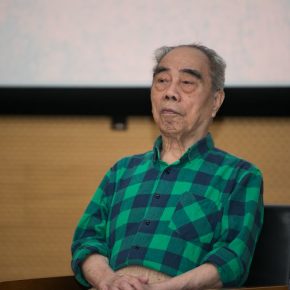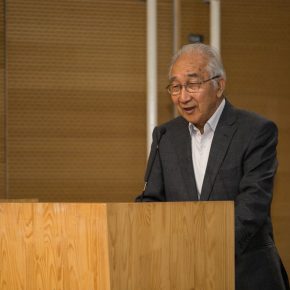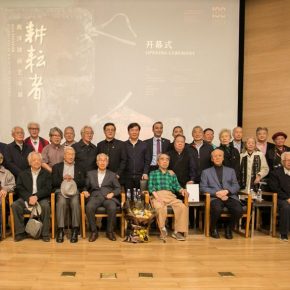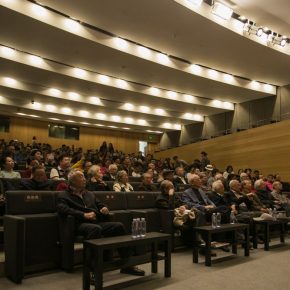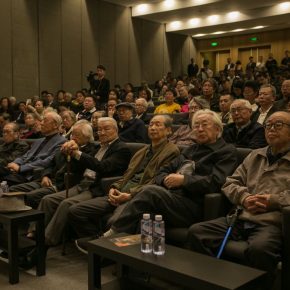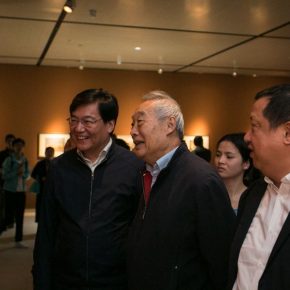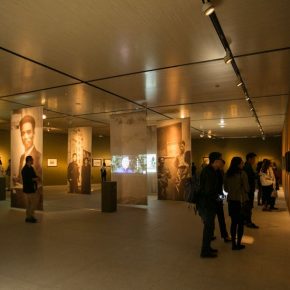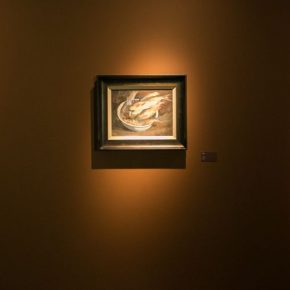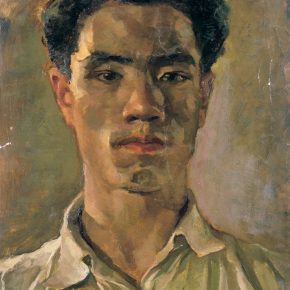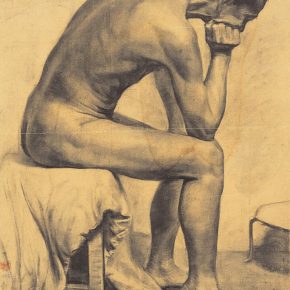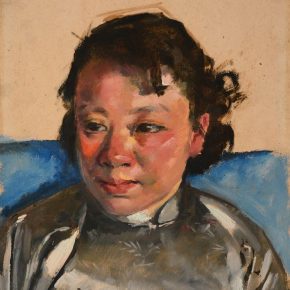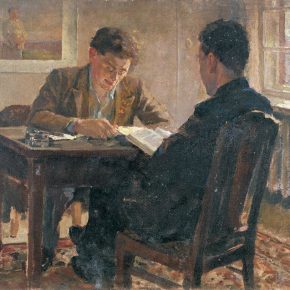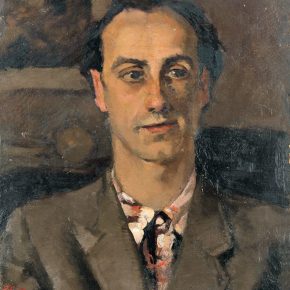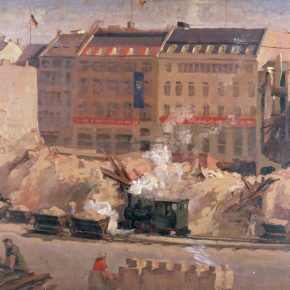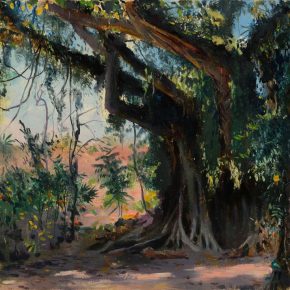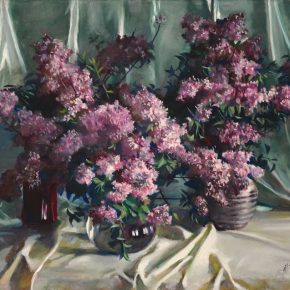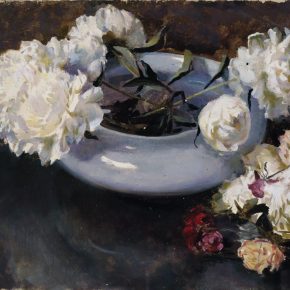
Following the “Xu Beihong—Living Art Forever” exhibition held in March 2018, “Cultivator: Exhibition of Dai Ze’s Oil Paintings” was presented at the Central Academy of Fine Arts. Xu Beihong and Dai Ze were both important figures in the field of oil painting in the 20th century and they were teacher and student, and two generations of oil painters. The predecessors’ artistic lives were reviewed in order to make the artistic experiences become the inspiration of current art creation and art education, and to enrich our understanding of the development of Chinese art and art education from the 20th century. In 1942, Dai Ze studied at the Central University, and Xu Beihong returned to China from Singapore and delivered a speech on “Ficus Virens and Sichuan People” at the Central University in the same year. Dai Ze was deeply touched, and he later became a student of Xu Beihong from 1945 to 1946. Inspired by the oil painting skill of “drawing a dirty picture to achieve many levels, and to depict the internal structure of the object, rather than a clean picture that is short of the content”, Dai Ze became a follower of Xu Beihong’s realistic painting.
As an artist, Dai Ze has spent more than 80 years constantly honing his painting skills, and has created thousands of oil paintings, watercolors, drawings, and paintings of ink and color. His works have both a solid foundation and a natural breath. As an art educator, he was invited by his teacher Xu Beihong in 1946 to teach at the National Beiping Art School in Beijing as a teaching assistant, and then he taught at the school till his retirement in 1987. Dai Ze has trained a large number of outstanding artists such as Jin Shangyi, Jin Zhilin and Yang Feiyun. As a student of Xu Beihong, he has also been involved in the restoration of Xu Beihong’s oil painting “Wait for Me” twice, and he has also copied the “Portrait of Empress Dowager Cixi” which had been exhibited in the Summer Palace for 30 years and became the important basis for the restoration of the original work of “Portrait of Empress Dowager Cixi” by Hubert Vos.
Dai Ze is a modest artist and has launched two large-scale exhibitions that feature a large number of high-quality works as he is now 96 years old. Many people who are interested in the art circle have visited the “Dai Ze Art Exhibition” at the National Museum of China this April, which was a comprehensive summary of the artistic life of the artist, while this show is a thematic retrospective trying to make a special presentation of the artist’s life of oil painting. As the curator Yu Ding said in an interview that: “Mr. Dai Ze is an oil painter from the beginning to the end, and he is also an oil painter who was deeply adored by Mr. Xu Beihong.”
In the course of the development of Chinese oil painting in the 20th century, Mr. Dai Ze has made outstanding contributions. The exhibition selects more than 150 oil paintings, which are divided into four parts to summarize his creations. “In the artistic creation, I have always followed the principle of realistic creation, and my artistic concept is that ‘nature is more important than all things’.” The first part of the exhibition, “Realistic Painting Ideals” presents dozens of sketches of a solid foundation, and several pieces show the backlit effect, such as two oil paintings on a wooden board, “Teaching Aids from the National Beiping Art School” (1946), “Two Translators” (1951), the oil painting on canvas, “Heating Stove (From the Home of Beiping Meizha Hutong) (1949), “Young Woman Painter Zhang Lanling from the National Beiping Art School” (1946) and the oil painting on paper, “Self-Portrait” (1949), etc., are typical realistic paintings.
“The majority of Dai Ze’s paintings are sketches. His painting skills are rooted in sketching and this part of creation is also derived from sketching, and all simple things he saw could be regarded as objects of paintings.” When Yang Feiyun worked in the Department of Oil Painting at the Central Academy of Fine Arts, he saw Dai Ze sketching every day in the U-shaped teaching building. Dai Ze’s paintings are very simple, and some people might misunderstand that those paintings were old or clumsy. However, with the growth of artistic experience, Yang Feiyun has increasingly realized that “Dai Ze’s paintings are the most fundamental core value of art: he used a more direct and simpler way to portray the human mind and people’s intense emotion to beautiful things”. The second part, “Simple Expression of Life” first displays an oil painting of “A Beggar” (1946) by Dai Ze. Rather than the portrayal of a man dressed in rags, he delicately portrayed the man’s face and eyes of the bust, deeply touching the viewer.
Thematic creation of a historical subject was the task of the times given to the oil painters in the second half of the 20th century, and it is also an important manifestation of the artist’s creative achievements. In 1948, Dai Ze created a unique painting of Beijing streetscape, entitled “Carriage”. He believed that the peasants with carriages were the hope of China at that time. Therefore, Dai Ze prepared a variety of small drafts for this piece from 1946, and specially invited models in order to conceive the picture. “Carriage” is the first successful thematic painting by Dai Ze. From 1949 to 1950, Dai Ze had participated in the meetings of the Beijing suburb Farmers Land Reform Association many times, and then he invited farmers to the school to be models for the creation of “A Meeting of the Farmers Group”. The third part of the exhibition, “The People-Centered Creation Theme”, features the works of historical themes, such as “Carriage” (1948), “A Meeting of the Farmers Group” (1950) and “Daze Village Uprising” (1971). In particular, the work of “A Meeting of the Farmers Group” presents his excellent composition of the painting of many people, as well as the dedicate depiction of the light and shadow. Hou Yimin, who participated in the meeting of the land reform together with Dai Ze, praised the painting and considered it as “one of the rare oil paintings by the people who participated in the land reform at that time.”
In the wedding congratulatory letter written by Xu Beihong to Dai Ze on his marriage, there were two sentences that state “The Artistic state has always been a consummate state, and one should do his best to cultivate and persist in this state.” As a witness to the history of Chinese oil painting in the 20th century, Dai Ze has carried out different explorations and experiences in the art system that he did his best to cultivate. Chinese elements were blended with Western techniques in the works created by the artist in old age, and he believes that “it was a stage that it naturally arrived and I also hope to take a small step forward in this aspect.” Dai Ze’s left eye was hurt due to a firecracker accident when he graduated from elementary school, so he has always relied on his right eye for painting. In 2008, the sight in his right eye was declining due to a cataract, but he still persisted in sketching although he could not go out. He drew the scenes outside the window, or still life and flowers at home till 2016. Dai Ze constantly searched for art, which was revealed in the fourth part, “Artistic Exploration in the Cultivation”.
It is extremely difficult to accurately summarize Dai Ze’s 70-year experience in creation. It is worth mentioning that as a student of Dai Ze, Jin Shangyi also personally participated in the selection of works for this oil painting exhibition, which adds to the readability of the exhibition. Jin Shangyi believes that reviewing Dai Ze’s sketches of oil paintings of the 1940s and 1950s will profoudly enlighten people.
President of the Central Academy of Fine Arts Fan Di’an wrote in the preface for the exhibition that, it collectively presented and systematically reviewed the oil painting creations by Dai Ze, and has an in-depth discussion on his position and contribution in the Chinese history of oil painting in the 20th century. It is a gift to the centennial celebration of the Central Academy of Fine Arts and a review of the history, as well as a presentation of the epoches.
“Reviewing the artists who were born and active in the last century is an urgent work of research and arrangment.” Prof. Yu Ding has long been paying attention to a group of artists of the 20th century, who are still alive or whose archives are completely saved, and trying to record and preserve the files of this group of artists. Over the years, he led a team to conduct research and reviews on Jiang Feng and Wei Qimei, and promoted the exhibitions of art works and documents to society and the public. Yu Ding frankly said that he was honored to curate this show. The review on all his works seem to be complicated and boring, but the success of each exhibition has filled the gap of art history of the 20th century. As Prof. Yu Ding said in his opening speech, the “Cultivator” is not only a summary of the artist’s creation in oil painting, but also an important case study of Chinese modern art history, especially the history of oil painting in the 20th century.
Text by Yang Zhonghui, translated by Chen Peihua and edited by Sue/CAFA ART INFO
Photo by Hu Sichen/CAFA ART INFO


